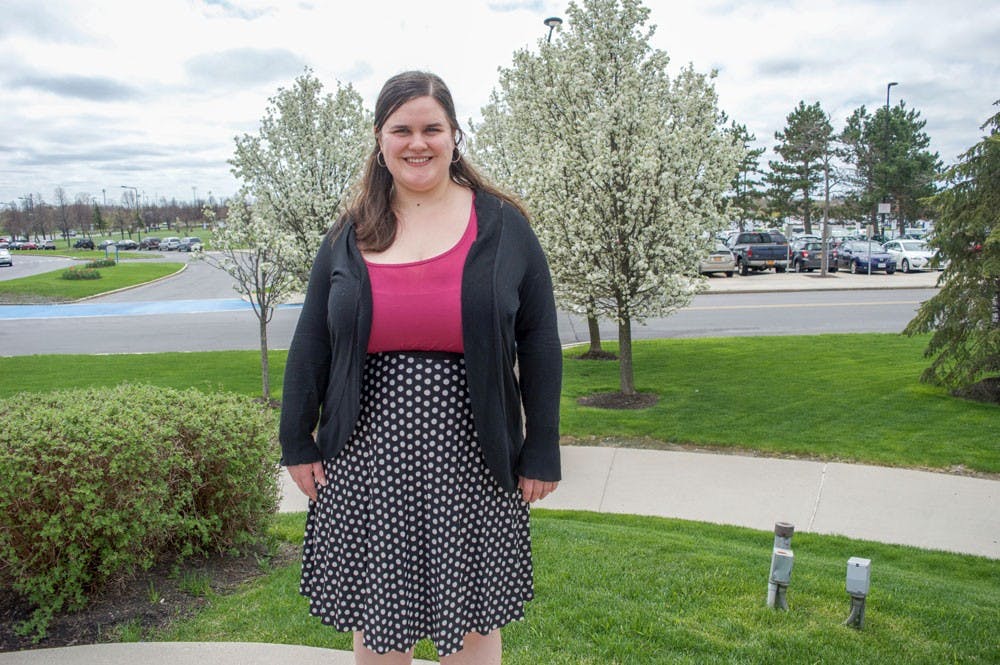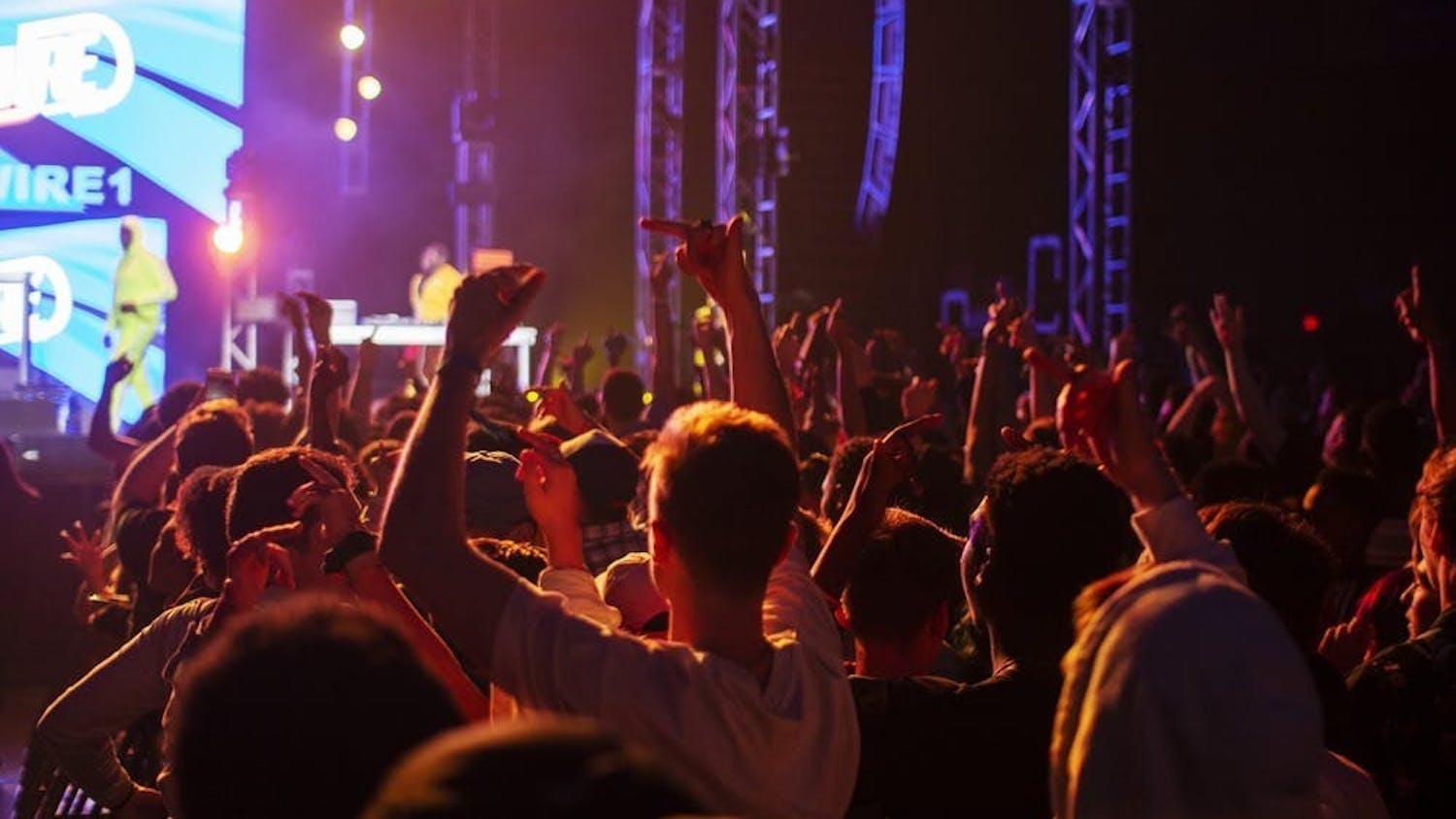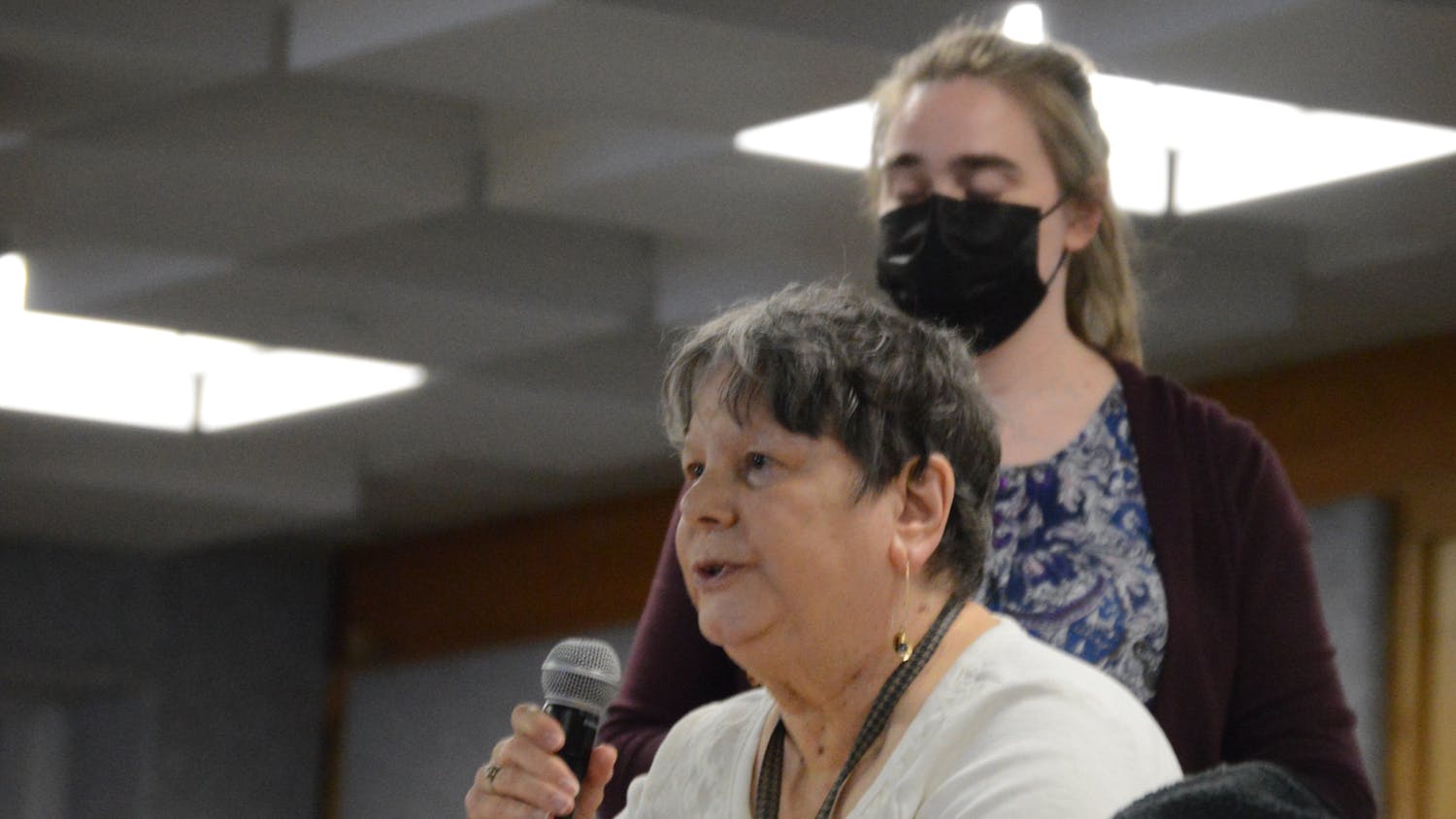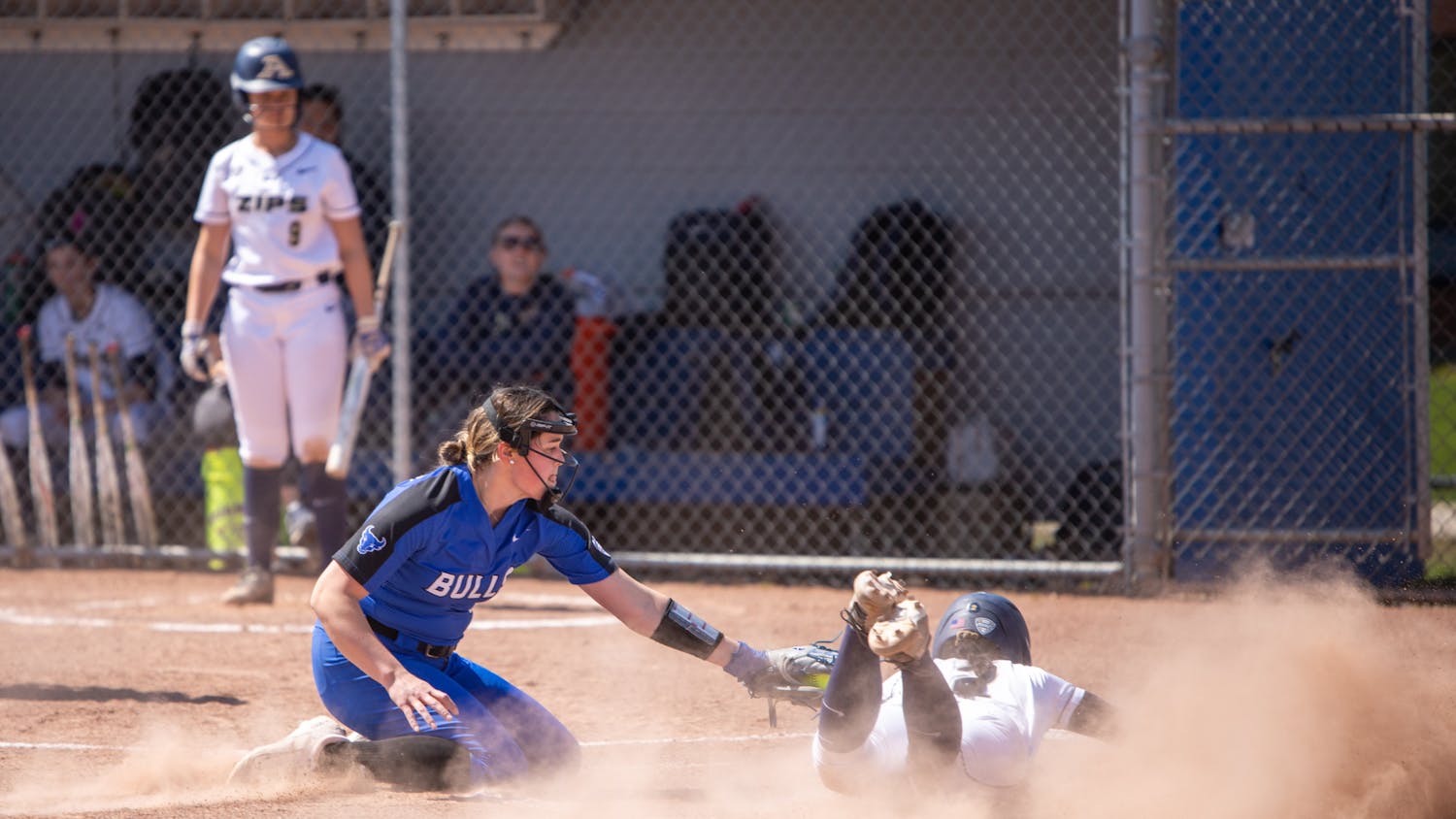Hilary Vandenbark has a secret dark place where shameful memories lurk.
She doesn’t like to go there, but she will if it can help UB students.
It was her senior year at Gonzaga University. She was studying abroad in France and met a man on the study abroad trip. Their groups were traveling to Germany together for Oktoberfest 2011.
But this man turned out to be dangerous and damaging.
He put his hand on her thigh. She kissed him back, hoping that was all he wanted. But he didn’t leave and Vandenbark sat silently as the scene escalated.
The shameful part is that she had a frozen response. She told herself the kiss is what allowed his next move.
But she never gave consent. She tried to stop him in English and in French. She pushed at his hands, his fingers, but he didn’t stop. He digitally penetrated her. He forcibly performed oral sex on her and then forced her to do it to him.
When it was over, she couldn’t speak. Shame overwhelmed her. She couldn’t describe what had happened. She didn’t want anyone to know. She thought if she hid it, it would go away.
It didn’t.
Vandenbark is now a Ph.D candidate in the Transnational Studies Department at UB and teaches a class on gender-based violence. Her memories and her paralysis in the face of a predator still haunt her. They also inform her teaching. She remembers feeling helpless and too embarrassed to speak about what had happened or report the crime.
She wants to reach out to undergrads – mirrors of her former self – and give them strength to talk. She’s been watching for the past few years as universities – under the weight of the federal government and increased public scrutiny – have struggled to set coherent and fair policies about how to deal with accusations of sexual assault on campuses.
One in five female undergraduates will be assaulted in her time at college, according to the federal government. Advocates and those assaulted insist the universities are not doing enough. They say universities have historically downplayed and under reported cases of sexual assault and that academic administrators are unqualified and unsuited to adjudicate a criminal act such as rape.
In 2014, the Obama administration took on the issue and put 55 campuses onto a federal list, meaning the federal government had concerns about how these campuses handled alleged campus assault cases.
Today, that list has grown more than five times, with 391 investigations, including one case from UB. The university has declined to give any details about the case.
There is also one 2014 case at Canisius and two 2015 cases at Buffalo State College. And there are 198 cases at graduate schools across the country.
Some universities on the list have worked to rapidly rewrite policies about how sexual assault cases are handled. UB created the Haven program, which is a mandatory online course for incoming students teaching them about UB’s sexual assault policies. Students and faculty can also request health-related workshops through Counseling Services’ website and the offices of 18 staff counselors are available for same-day appointments.
Services include mental health counseling, stress, suicide, depression and grief, sexual health and preventing sexual violence, according to the Counseling Services website.
“We have people here at UB who can help students through the process and advocate for you, students just have to use the resources,” said Anna Sotelo-Peryea, the violence prevention coordinator in Wellness Education Services.
But Vandenbark says it’s not enough.
She wants to help eliminate the secrecy and shame that campus sexual assault engenders. Part of that, she says, is pushing universities to be more transparent when sexual assault cases happen and to explain how cases get adjudicated.
“Universities don’t want the reputation of being a rapey school and the more transparency there is, the more room there is for discussion,” Vandenbark said.
She understands the delicacy of the cases, the fragility of the victims and their memories, particularly when they don’t report an incident right away. She knows the desperate desire for privacy students who’ve been assaulted feel and the courage it takes to come forward. Yet, by making almost everything about the cases secret, university administrators are adding to the problem, she said.
She and other faculty have written a letter asking UB to release a formal statement “apologizing for trivializing sexual violence,” hire more qualified people in Wellness Education Services and Office of Equity, Diversity and Inclusion, and maintain and distribute an annual sexual misconduct report that includes complaints of administration’s handling. There are eight people on Wellness Education Services’ team and seven people listed as staff for Equity Diversity and Inclusion.
“Parents want to send their children to a school that is safe and a school that is actively discussing sexual assault rather than trying to hide it,” Vandenbark said. “UB has the services that deal with the issue, but administration is not dealing with it.”
During the 2014-15 year, 10 students reported sexual assaults, said Sharon Nolan-Weiss, director of Equity, Diversity and Inclusion. Four of the cases resulted in long-term suspension or expulsion. In 2016 – the first full year there was a Crisis Services advocate on campus – the number of reported assaults and/or domestic violence incidents jumped to 26. Sotelo-Peryea believes the jump is due to increased awareness. Of those cases, 14 were reported to the university and 18 were reported to police.
The university’s role
One of the biggest questions about campus sexual assault cases is the most basic: why are academic administrators handling cases that are arguably the job of police?
The answer is both simple and complex and begins with Title IX, the federal law that protects against discrimination in education. Under it, universities are legally required to address sexual harassment and violence on campus. That includes sexual assaults.
If the university wasn’t able to intervene, Nolan-Weiss feels that would be problematic.
“We’re here because we know the criminal process may take months and years and in the meantime, we may have someone on campus who is a continuing threat,” she said.
How they handle these cases – many of which consist of conflicting accounts, little forensic evidence and the muddled memories of students who often were partially to fully intoxicated – varies by institution. The process – all of which occurs behind closed doors – has left both alleged victims and alleged perpetrators angry.
Students on both sides have sued universities in recent years for the uneven and convoluted handling of specific cases. Other students have sought to publicly embarrass their universities.
Former Columbia University student Emma Sulkowicz carried a mattress on her back for almost a year to protest Columbia’s refusal to expel her alleged rapist. Students have written viral blog posts about alleged campus rapes that were unfairly handled. Students have filed lawsuits against the Universities of Chicago, Colorado, Miami, Texas-Pan American as well as Harvard, faulting them for inadequate handling of rape allegations.
Last year, former Vanderbilt football player Brandon Vandenburg received 17 years in prison for raping an unconscious student. After former Stanford swimmer Brock Turner received a six-month sentence for allegedly sexual assaulting an unconscious 20-year-old, his victim wrote him an open letter that went viral.
Then-Vice President Joe Biden wrote back to her in an open letter, saying, "And I am filled with furious anger – both that this happened to you and that our culture is still so broken that you were ever put in the position of defending your own worth.”
And yet, despite the publicity sexual assault on campus has received, insensitivity continues.
Last Wednesday, Niagara County Community College President James P. Klyczek stepped down amid leaked recordings of him calling a sexual assault victim “stupid” and “dumber than a doorknob.”
UB, too, is under scrutiny.
On May 12, 2016, the federal government told UB the university had been placed on the Department of Education Office for Civil Right’s (OCR) list of colleges that allegedly mishandled sexual assault cases.
The university did not alert students, staff and faculty about the placement until August 11, 2016. The university never sent out a notice about the original sexual assault incident. The Spectrum and faculty members have asked for basic details of the case – when it happened, where it happened, and if the student knew the alleged male perpetrator – for close to a year, but have received no information.
The Spectrum has found out that the student complained to OCR that UB retaliated against him/her by suggesting that the university could take disciplinary action against the student over the case. The Spectrum cannot read details of the complaint because large sections are censored.
UB administrators defend the school’s actions and say the school’s appearance on OCR’s list does not mean the university mishandled a case.
“This list doesn’t mean UB broke any law,” Nolan-Weiss said. “It’s a list of colleges across the nation where a student filed a complaint because something could have been handled differently.”
The Spectrum asked President Satish Tripathi why an alert was never sent out to the UB community about the sexual assault. The 1990 Jeanne Clery Act requires all universities that get federal financial aid to disclose information about crime on and near campuses. The idea is to protect students in case a dangerous suspect is on the loose. Failure to comply can lead to penalties of up to $35,000.
Tripathi responded through UB Spokesperson John Della Contrada, who said an alert about the sexual assault was never sent to the community because university police “didn’t see it as an immediate threat.”
Vandenbark and 92 cosigners in the UB community – including faculty and students – wrote a Feb. 3 letter in The Spectrum about the university’s silence on the case. In the letter, they said the university places students in “more vulnerable positions” by not sending out an alert and that “sexual violence is always an immediate threat.”
“I was thinking about my students and I want them to feel like they have a safe space here,” Vandenbark said. “Most rape occurs when two people know each other or mutual acquaintance and that didn’t seem important in the president’s office.”
After the letter appeared, Della Contrada reached out to Vandenbark privately, apologizing for “the apparent insensitivity,” she said.
“That response was a little disappointing because he only apologized for how the comment appeared and not what the comments were saying and that’s what my letter was trying to address,” Vandenbark said. “My letter to the editor was in a public forum and it seemed like they wanted it to be a private conversation. A response from the president should also be made in a public forum.”

If the federal statistics about campus sexual assault are right, then in every class of 30 women at UB, six will be assaulted before she graduates. In The Spectrum office, that’s four of us. On the volleyball team, it’s three and across the campus of 30,000, it’s about 3,000, assuming about half the campus undergraduates are women. And of course, women are not the only ones being assaulted.
It’s happening all around us, yet students don’t report it.
Only 8 percent of UB students who’ve been sexually assaulted have reported it, according to the SUNY campus climate report, a survey where students share their experiences with sexual violence and other crimes.
The Spectrum spoke to 14 female UB students who claim to have been sexually assaulted. None of them wanted to tell their story. They were afraid of people recognizing who they are and others felt talking about it would be too triggering. None of them have reported the assault.
Like Vandenbark, they have dark places of shame.
Some of the students interviewed didn’t realize what had happened to them was a sexual assault until weeks, months and even years afterward. If they had come forward, they would have had little evidence other than their memories and shame.
Still, these students have options, Nolan-Weiss said, and will be put in touch with both a Title IX officer and Judicial Affairs, who will lead them through the complaint process.
When students do come forward months after an assault, the university has to decide what – if anything – to report to the student body. The Clery Act and Department of Education guidelines mandate that alerts be sent in cases of “an immediate danger,” such as an active shooter on campus, a fire or an act of terrorism.
Sexual assault falls into that category when the predator is still around.
“In situations where we can identify the perpetrator and make a risk assessment as to whether they pose a continuing threat to students, we’ll do that assessment and if there does not appear to be a continuing threat in that situation, it may not warrant a timely warning,” Nolan -Weiss said. “What we hear from victims is that the timely warning can be triggering for them.”
Sotelo-Peryea also feels sending out alerts will “create a chilling effect” on victims.
“Without identifying exactly who it is that’s accused, I don’t see how it will make the campus any safer by publishing every time a person comes forward,” she said.
Whether an alert is sent out or not, students can pursue a criminal complaint and/or a code of conductcomplaint through the student conduct process.
Students also have the option to have support resources, such as counseling services, medical care and academic accommodations.
Judicial Affairs also handles cases of false claims, like the February incident in which a UB student reported she had been assaulted by black two men near the Ellicott Complex on North Campus. UB sent out an alert about the assault and the campus buzzed with fear. Two days later, the student told investigators the incident never happened.
Now, the case is being reviewed as a violation and may result in criminal prosecution, Nolan-Weiss said.
She highlighted the enormous difference between a false case and a case where the facts remain unproven.
UB’s solution to the problem
In addition to more openness from administrators, Vandenbark also wants to make information about sexual assault clearer for victims sorting through their options. She calls UB’s current webpage “disorganized” and says recourses are not straightforward. Vandenbark feels the website may steer some victims away.
And, she says, there is little that helps students understand how sex should happen. The best way to prevent sexual assault, she said, is to “promote good, healthy sex.”
“Healthy sex life means consent before, during and after, and communicating what you’re willing and not willing to do. When you’re drinking and at a party, it’s hard to have those conversations and they’re very necessary. It’s about mutual pleasure and safety,” Vandenbark said.
Some people have criticized this theory and the “yes means yes” policy, which requires an explicit “yes” before every kiss, touch or sexual overture. Students say it’s impractical, especially when alcohol is involved.
But administrators believe sexual assault prevention is through education.
In 2014, UB implemented the online Haven program, which all students have to partially complete before they arrive on campus. They have to finish the program by the end of their first semester.
The course takes students through different sexual assault scenarios as an attempt to give them an understanding of UB’s policies.
“You’re going to forget a lot of that when you get into party mode. So that information needs to be in your face at all times,” Vandenbark said.
Sotelo-Peryea sees the program as a success and said that since Haven began, students have shown an 81 percent increase in understanding of school policies on sexual assault. Students take a survey before and after finishing the course based on their understanding of sexual assault.
“I know no one likes requirements, but we’re making a lot of progress with this course,” Sotelo-Peryea said.
Haven has also showed administration how many students are coming to UB with past experiences with sexual assault.
For the 2016-17 year, 15 percent of women and 3 percent of men said they experienced some form of sexual assault before coming to UB. Four percent of women and 2 percent of men said they experienced some form of sexual assault after they arrived.
Along with Haven, UB also has training sessions on helping sexual assault survivors and bystander intervention training. But not all students who have been affected by sexual assault participate.
Vandenbark feels this is too little. She’s working hard in her classes and in her outreach to shift students’ perception about sexual assault and to help them understand that just because they “don’t have a cookie-cutter rape story,” it doesn’t mean they weren’t sexually assaulted.
For years, she hid her shame. She tried to shrug off her night in Germany as a “bad, awkward hookup.”
Now she knows that talking and awareness about what’s permissible and what’s not is crucial.
“People have the right to good sex and people have the right to not be raped,” Vandenbark said. “I wish I knew then what I know now.”
Gabriela Julia is the editor in chief and can be reached at gabriela.julia@ubspectrum.com





